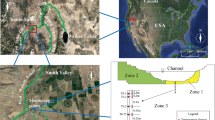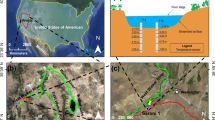Abstract
Groundwater-surface water interactions in rivers are a critically important factor for fish spawning, as streamwater downwelling or upwelling of low-oxygen groundwater can affect egg survival. Assessing such dynamics at the reach scale using distributed temperature measurements as a tracer proved reliable in determining flux rates and directions in the hyporheic zone in a number of studies. Here, we report heat-based vertical flux rates from a heterogeneous gravel-bed stream reach used by spawning Atlantic salmon in the Scottish Highlands. Results showed mostly small downwelling fluxes (~0.3 m d−1), which were largely independent of discharge. Contrasting, and at times unusual flux-depth profiles (e.g., increasing flux with depth) were detected, consistent with the heterogeneous streambed material causing diverse hyporheic flow paths. This was tested in a numerical 2-D model setup attempting to reproduce such behavior with variable random hydraulic conductivity (K) fields. The 2-D model clearly demonstrated that strong deviations from the expected decrease of fluxes with depth can be explained by high heterogeneity coupled with relatively low K fields. This showed that using simple 1-D heat-based flux estimates in combination with 2-D models is a useful approach to testing hypotheses about the influence of variable streambed materials on groundwater–surface water exchange in an ecological context.







Similar content being viewed by others
References
Addy S, Soulsby C, Hartley AJ, Tetzlaff D (2011) Characterisation of and controls on channel reach morphology in deglaciated montane catchments in the Cairngorms, Scotland. Geomorphology 132:176–186
Anderson MP (2005) Heat as a ground water tracer. Ground Water 43(6):951–968
Bhaskar AS, Harvey JW, Henry EJ (2012) Resolving hyporheic and groundwater components of streambed water flux using heat as a tracer. Water Resour Res 48:W08524. doi:10.1029/2011WR011784
Birkel C, Tetzlaff D, Dunn SM, Soulsby C (2010) Towards simple dynamic process conceptualization in rainfall-runoff models using multi-criteria calibration and tracers in temperate, upland catchments. Hydro Process 24:260–275
Birkel C, Tetzlaff D, Dunn SM, Soulsby C (2011) Using time domain and geographic source tracers to conceptualize streamflow generation processes in lumped rainfall-runoff models. Water Resour Res 47:W02515. doi:10.1029/2010WR009547
Briggs MA, Lautz LK, Gordon RP, McKenzie JM, Hare DK (2012) High resolution fiber-optic distributed temperature sensing of hyporheic flux patterns in varied space and time around beaver dams. Water Resour Res 48:W02527. doi:10.1029/2011WR011227
Cardenas MB (2009) Stream-aquifer interactions and hyporheic exchange in gaining and losing sinuous streams. Water Resour Res 45:W06429. doi:10.1029/2008WR007651
Cardenas MB, Wilson JL (2007) Effects of current-bed form induced fluid flow on the thermal regime of sediments. Water Resour Res 43:W08431. doi:10.1029/2006WR005343
Cardenas MB, Zlotnik VA (2003) Three-dimensional model of modern channel bend deposits. Water Resour Res 39:1141. doi:10.1029/2002WR001383
Cardenas MB, Wilson JL, Zlotnik VA (2004) Impact of heterogeneity, bedforms, and stream curvature on subchannel hyporheic exchange. Water Resour Res 40:W08307. doi:10.1029/2004WR003008
Conant B (2004) Delineating and quantifying ground water discharge zones using streambed temperatures. Ground Water 42(2):243–257
Cranswick RH, Cook PG, Shanafield M, Lamontagne S (2014) The vertical variability of hyporheic fluxes inferred from riverbed temperature data. Water Resour Res 50:3994–4010. doi:10.1002/2013WR014410
Curry RA, Gehrels J, Noakes DLG, Swainson R (1994) Effects of river flow fluctuations on groundwater discharge through brook trout, Salvelinus fontinalis, spawning and incubation habitats. Hydrobiologia 277(2):121–134. doi:10.1007/BF00016759
Cuthbert MO, Mackay R (2013) Impacts of nonuniform flow on estimates of vertical streambed flux. Water Resour Res. doi:10.1029/2011WR011587
Deutsch CV, Journel AG (1998) GSLIB: Geostatistical Software Library and User’s Guide, 2nd edn. Oxford University Press, New York
Dick J, Tetzlaff D, Soulsby C (2015) Landscape influence on small-scale water temperature variations in a moorland catchment. Hydrol Process. doi:10.1002/hyp.10423
Geist DR, Arntzen EV, Murray CJ, McGrath KE, Bott Y-J, Hanrahan TP (2008) Influence of river level on temperature and hydraulic gradients in chum and fall Chinook salmon spawning areas downstream of Bonneville Dam, Columbia River. North Am J Fish Manag 27:30–41
Genereux DP, Leahy S, Mitasova H, Kennedy CD, Corbett DR (2008) Spatial and temporal variability of streambed hydraulic conductivity in West Bear Creek, North Carolina, USA. J Hydrol 358:332–353
Gomez-Velez JD, Krause S, Wilson JL (2014) Effect of low-permeability layers on spatial patterns of hyporheic exchange and groundwater upwelling. Water Resour Res 50:5196–5215. doi:10.1002/2013WR015054
Gordon RP, Lautz LK, Briggs MA, McKenzie JM (2012) Automated calculation of vertical pore-water flux from field temperature time series using the VFLUX method and computer program. J Hydrol. doi:10.1016/j.jhydrol.2011.11.053
Hatch CE, Fisher AT, Revenaugh JS, Constantz J, Ruehl C (2006) Quantifying surface water–groundwater interactions using time series analysis of streambed thermal records: method development. Water Resour Res 42(10):W10410
Irvine DJ, Brunner P, Hendricks Franssen H-J, Simmons CT (2012) Heterogeneous or homogeneous? Implications of simplifying heterogeneous streambeds in models of losing streams. J Hydrol 424–425:16–23
Irvine DJ, Cranswick RH, Simmons CT, Shanafield MA, Lautz LK (2015) The effect of streambed heterogeneity on groundwater-surface water exchange fluxes inferred from temperature time series. Water Resour Res. doi:10.1002/2014WR015769
Kalbus E, Reinstorf F, Schirmer M (2006) Measuring methods for groundwater-surface water interactions: a review. Hydrol Earth Syst Sci 10:873–887
Käser DH, Binley A, Heathwaite AL, Krause S (2009) Spatio-temporal variations of hyporheic flow in a riffle-step-pool sequence. Hydrol Process 23:2138–2149
Keery J, Binley A, Crook N, Smith JWN (2007) Temporal and spatial variability of groundwater–surface water fluxes: development and application of an analytical method using temperature time series. J Hydrol 336(1–2):1–16
Lautz LK (2010) Impacts of nonideal field conditions on vertical water velocity estimates from streambed temperature time series. Water Resour Res 46:W01509. doi:10.1029/2009WR007917
Lautz LK, Kranes NT, Siegel DI (2010) Heat tracing of heterogeneous hyporheic exchange adjacent to in-stream geomorphic features. Hydrol Process 24(21):3074–3086
Leek R, Wu JQ, Wang L, Hanrahan TP, Barber ME, Qiu H (2009) Heterogeneous characteristics of streambed saturated hydraulic conductivity of the Touchet River, south eastern Washington, USA. Hydrol Process 23:1236–1246
Leman VN (1993) Spawning sites of chum salmon, Oncorhynchus keta: microhydrological regime and viability of progeny in redds (Kamchatka River basin). J Ichthyol 33:104–117
Malcolm IA, Soulsby C, Youngson AF (2002) Thermal regimes in the hyporheic zone of two contrasting salmon spawning streams; hydrological and ecological implications. Fish Manage Ecol 9:1–10
Malcolm IA, Soulsby C, Youngson AF, Hannah DM, McLaren IS, Thorne A (2004) Hydrological influences on hyporheic water quality: implications for salmonid survival. Hydrol Process 18:1521–1542
Malcolm IA, Soulsby C, Youngson AF, Hannah DM (2005) Catchment scale controls on groundwater—surface water interactions in the hyporheic zone: implications for salmon embryo survival. Rivers Res Appl 21:977–989
Malcolm IA, Youngson AF, Greig S, Soulsby C (2008) Hyporheic influences on spawning success. In: Sear D, DeVries P (eds) Salmon spawning habitat in rivers: physical controls, biological responses and approaches to remediation. American Fisheries Society, Symposium 65. Bethesda, Maryland, pp 225–248
Malcolm IA, Youngson AF, Soulsby C, Imholt C, Fryer RJ (2011) Is interstitial velocity a good predictor of salmonid embryo survival? Trans Am Fish Soc 140(4):898–904
Malcolm IA, Gibbins CN, Soulsby C, Tetzlaff D (2012) The influence of hydrology and hydraulics on salmonids between spawning and emergence: implications for the management of flows in regulated rivers. Fish Manage Ecol. doi:10.1111/j.1365-2400.2011.00836.x
McCallum AM, Andersen MS, Rau GC, Acworth RI (2012) A 1-D analytical method for estimating surface water–groundwater interactions and effective thermal diffusivity using temperature time series. Water Resour Res 48:W11532. doi:10.1029/2012WR012007
Moir HJ, Soulsby C, Youngson AF (2002) Hydraulic and sedimentary controls on the availability and use of Atlantic salmon (Salmo salar) spawning habitat in the River Dee system, northeast Scotland. Geomorphology 45:291–308
Moir HJ, Gibbins CN, Soulsby C, Webb J (2004) Linking channel geomorphic characteristics to spatial patterns of spawning activity and discharge use by Atlantic salmon (Salmo salar L.) in two upland Scottish streams. Geomorphology 60:21–35
Rau GC, Andersen MS, Acworth RI (2012) Experimental investigation of the thermal time-series method for surface water-groundwater interactions. Water Resour Res 48:W03530. doi:10.1029/2011WR011560
Roshan H, Rau GC, Andersen MS, Acworth RI (2012) Use of heat as tracer to quantify vertical streambed flow in a two-dimensional flow field. Water Resour Res 48:W10508. doi:10.1029/2012WR011918
Selker JS, Thévenaz T, Huwald H, Mallet A, Luxemburg W, van de Giesen N, Stejskal M, Zeman J, Westhoff M, Parlange MB (2006) Distributed fiber-optic temperature sensing for hydrologic systems. Water Resour Res 42:W12202. doi:10.1029/2006WR005326
Shanafield M, Pohll G, Susfalk R (2010) Use of heat-based vertical fluxes to approximate total flux in simple channels. Water Resour Res 46:W03508. doi:10.1029/2009WR007956
Shanafield M, Hatch C, Pohll G (2011) Uncertainty in thermal time series analysis estimates of streambed water flux. Water Resour Res 47:W03504. doi:10.1029/2010WR009574
Soulsby C, Malcolm IA, Youngson AF, Tetzlaff D, Gibbins CN, Hannah DM (2005) Groundwater—surface water interactions in upland Scottish rivers: hydrological, hydrochemical and ecological implications. Scott J Geol 41:39–49
Sowden TK, Power G (1985) Prediction of rainbow trout embryo survival in relation to groundwater seepage and particle size of spawning substrates. Trans Am Fish Soc 114:804–812
Swanson TE, Cardenas MB (2010) Diel heat transport within the hyporheic zone of a pool-riffle-pool sequence of a losing stream and evaluation of models for fluid flux estimation using heat. Limnol Oceanogr 55(4):1741–1754
Tetzlaff D, Soulsby C, Waldron S, Malcolm IA, Bacon PJ, Dunn SM, Lilly L (2007) Conceptualisation of runoff processes using GIS and tracers in a nested mesoscale catchment. Hydrol Process 21:1289–1307
Tetzlaff D, Birkel C, Dick J, Soulsby C (2014) Storage dynamics in hydropedological units control hillslope connectivity, runoff generation and the evolution of catchment transit time distributions. Water Resour Res 50:969–985. doi:10.1002/2013WR014147
Therrien R, McLaren RG, Sudicky EA, Panday SM (2006) HydroGeoSphere, Groundwater Simulations Group. University of Waterloo, Ontario
Tonina D, Buffington JM (2007) Hyporheic exchange in gravel bed rivers with pool-riffle morphology: laboratory experiments and three-dimensional modeling. Water Resour Res 43:W01421. doi:10.1029/2005WR004328
Wörman A, Riml J, Schmadel N, Neilson BT, Bottacin-Busolin A, Heavilin JE (2012) Spectral scaling of heat fluxes in streambed sediments. Geophys Res Lett 39:L23402
Young PC, Pedregal DJ, Tych W (1999) Dynamic harmonic regression. J Forecast 18(6):369–394
Youngson AF, Malcolm IA, Thorley JL, Bacon PJ, Soulsby C (2005) Long-residence groundwater effects on incubating salmonid eggs: low hyporheic oxygen impairs embryo development and causes mortality. Can J Fish Aquat Sci 61:2278–2287
Acknowledgments
We thank J. Grant for her efforts in the field collecting the data used in this study. Auxiliary data provided by Marine Sciences Scotland, Freshwater Laboratory and the Scottish Environmental Protection Agency. Dylan Irvine and Laura Lautz were supported by the National Science Foundation under Grant No. EAR–0901480.
Author information
Authors and Affiliations
Corresponding author
Rights and permissions
About this article
Cite this article
Birkel, C., Soulsby, C., Irvine, D.J. et al. Heat-based hyporheic flux calculations in heterogeneous salmon spawning gravels. Aquat Sci 78, 203–213 (2016). https://doi.org/10.1007/s00027-015-0417-4
Received:
Accepted:
Published:
Issue Date:
DOI: https://doi.org/10.1007/s00027-015-0417-4




